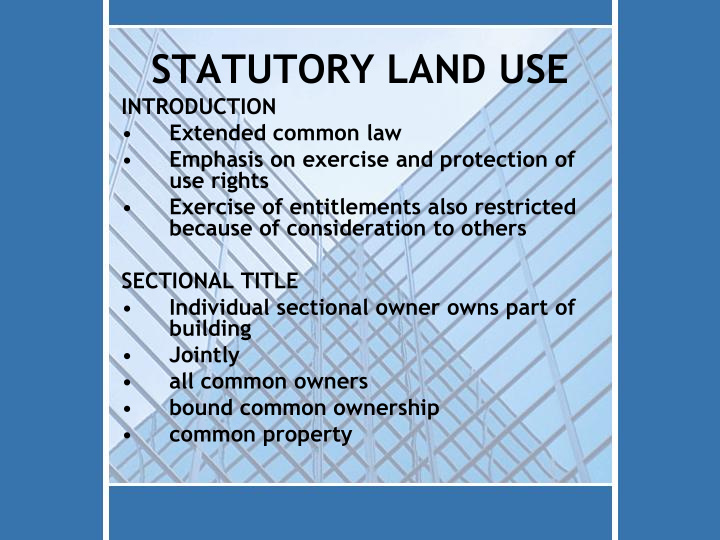



STATUTORY LAND USE INTRODUCTION • Extended common law • Emphasis on exercise and protection of use rights • Exercise of entitlements also restricted because of consideration to others SECTIONAL TITLE • Individual sectional owner owns part of building • Jointly • all common owners • bound common ownership • common property
Learning outcomes of this Unit • Formulate the new forms of land use regulated by statute and formulate advice on the advantages and disadvantages of each. • Detect the changes to common law principles regarding ownership of immovable property with the commencement of these statutes. • Catalogue the meaning, functioning and establishment of the following terms: - sectional title - share blocks - time-sharing
Learning outcomes (continued…) • Demonstrate a knowledge of the calculation of a participation quota and what it determines. • Formulate the documents that should accompany the developer’s application for registration of the sectional plan and the opening of a sectional title register. • Differentiate between the different forms of housing development schemes for retired persons. • Lay out the nature of the right that a retired person has in a housing development scheme. This unit is based on Chapter 6 of Van der Walt and Pienaar (2009)
Sectional title unit Composite immovable thing Individual owner of a section of a building 2 components Plus undivided share in common property Anything not part of a section, eg hallways, stairs, lift
Amendment of common law principles Common law principle Sectional title principle (still applicable in (only applicable on ordinary ownership sectional title schemes) relationships) • Owner of things • Not jointly owners, each permanently attached sole owner of part ( superficies solo cedit) • Section has horizontal and • Air space above( cuiius est vertical boundaries solum) • Joint exercise regarding • Exercise entitlements of common property use and enjoyment without • Bound common interference (plena in re ownership: potestas) Not use actio communi • Free co-owner can any dividundo to divide time divide land or alienate property undivided share Alienation limited to section of building;Not right to veto in case of legal action;Body corporate performs legal action;Owner of particular section not ideal nature
Legal nature of sectional ownership Indicated on sectional plan with reference to walls, floors and ceilings. Includes parts such as Section porch, lobby, balcony, forecourt that belongs with section Sectional title unit Undivided share in common property Calculated with reference to participation quota
DEFINITIONS(continued…) Know when this will be used: • Unanimous resolution • Special resolution • Rules - Management rules - Rules of conduct
Procedure to establish • Draft sectional plan • Notice to tenants • Approval by surveyor – general • Opening of sectional title register and registration of sectional plan • Alienation of units • Protection of tenants - Notice - First offer
Extension of scheme Complete or erect further developments (What is the legal nature of the right to extend a sectional title scheme, how is it created and how is it transferred?)
Activity 1: Destruction of building When can a building regarded so?
SHARE BLOCKS • Functioning of share block scheme • Protective measures • The legal nature of the right to occupy a share block unit
Activity 2: List the advantages and disadvantages of this form of statutory land use.
TIME-SHARING • Legal nature • Protection of purchaser • As basis of club (read) • Levies
Activity 3: List the advantages and disadvantages of this form of ownership of property.
HOUSING DEVELOPMENT SCHEMES FOR RETIRED PERSONS • Housing interest • Types of schemes • Legal nature of right
Activity 4: Discuss the legal nature of the right obtained by a housing development scheme for retired persons and describe in which way can it be statutorily protected?
Recommend
More recommend